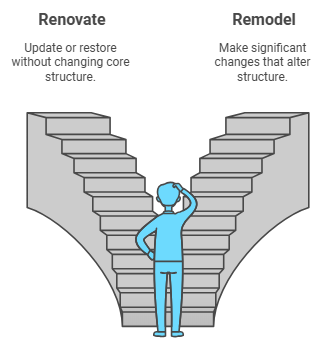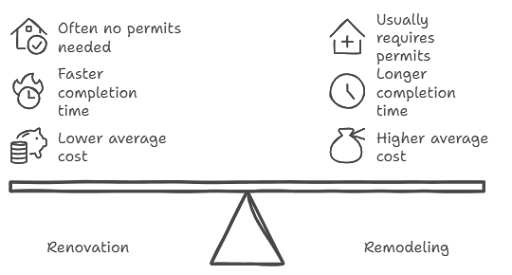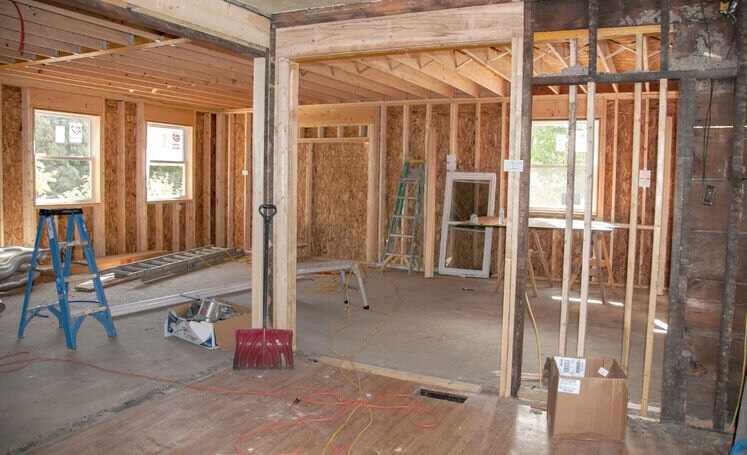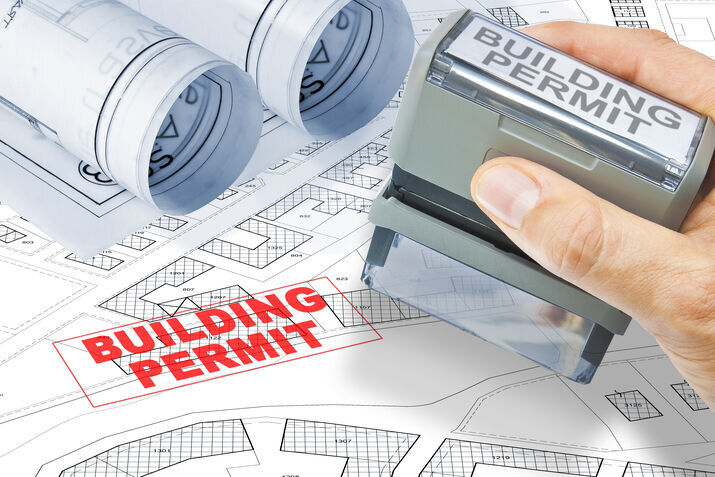In 2024, the average home cost in the United States hovers around the $500,000 mark. With a national average of $63,795, buying a new house in place of the old one isn’t exactly a luxury that most Americans have anymore–so you might need to postpone looking for a realtor.
But instead, you can consider renovating or remodeling.
Renovation improves the home’s overall functionality and can improve quality of life at a decent cost. Remodeling takes more time and often a significant amount of money, but sometimes, it can be the only option.
And since you’re here to learn how to save money, let’s compare renovations vs. remodeling in detail and see which might be the better option for you and your family.
Contents
At a Glance
| Aspect | Renovation | Remodeling |
|---|---|---|
| Definition | Updating or restoring without structural changes. | Making significant changes that alter the structure. |
| Cost | Generally lower, averaging around $52,068. | Higher, ranging from $20,000 to over $100,000. |
| Time | Quicker, typically days to weeks. | Longer, often several months to a year. |
| Permissions | Usually doesn’t require permits for minor updates. | Often requires permits due to structural changes. |
| Example Projects | Bathroom updates, kitchen facelifts, living room refreshes. | Open floor plan conversions, attic transformations, basement finishes. |
| When to Choose | For minor updates, outdated spaces, or preparing to sell. | For significant space needs, changing family dynamics, or emotional attachments. |
A General Look at Renovation and Remodeling

Renovation projects involve updating or restoring parts of a home without changing its core structure or layout. It’s like refreshing the house—painting, updating plumbing fixtures, or installing new flooring.
Remodeling projects, on the other hand, means making significant changes that can alter the home’s structure. This could involve changing the floor plan, knocking down walls, or adding entirely new spaces. Essentially, remodeling is about transforming the space.
On paper, a home renovation project is theoretically the more convenient choice, especially if all you need is some quick changes. However, that’s not always the case. To decide which is better for your individual scenario, we need to expand a little more on the differences between the two.
The Key Differences Between Renovation and Remodeling

Let’s have a deeper look at the difference between the two types of home improvement:
Cost

Let’s start with the cost. It’s about saving money, after all. So, it’s worth considering whether you actually need to change the existing layout or just settle for minor renovations.
Renovation
While the numbers can vary significantly, the cost of renovating a home in the U.S. typically ranges from $19,529 to $88,043, with an average cost of around $52,068 for homes between 1,250 and 1,600 square feet.
Additionally, the average cost for renovations and light fixtures is about $15 to $60 per square foot, depending on the quality of materials and the extent of the work.
If we’re looking at room-specific costs:
- Kitchen Renovation: Approximately $14,550 to $40,400.
- Bathroom Renovation: Typically ranges from $6,634 to $17,579, averaging around $12,0634.
- Living Room Renovation: Costs about $5,000 to $10,000.
Remodeling
The costs of remodeling a house can range from $20,000 to $100,000, depending on the size and complexity of the project. Remodeling costs can be higher, especially for kitchens and bathrooms, which average between $100 to $250 per square foot.
Once again, room specifics:
- Kitchen Remodel: Minor remodels can start at around $10,000, while major renovations can exceed $100,000.
- Bathroom Remodel: Costs typically range from $5,000 to $25,000 for comprehensive updates.
- Living Room Remodel: Costs about $8,000 to $15,000 for various updates and changes
Time
Renovations are almost always faster than remodeling, but just by how much?
Renovation

Simple renovation projects like repainting a room or updating fixtures can take a few days to a few weeks. On the other hand, extensive renovations and more significant updates, such as kitchen renovations, may take a few weeks to a couple of months.
Yes, we did say “months” here, but it’s still fairly faster than remodeling.
Remodeling

Remodeling projects often require more time due to structural changes. Typical timelines include:
- Room Additions or Conversions: These can take several months.
- Full Home Remodels: Larger projects, like a complete home makeover, typically last between 6 months to a year or more.
Once again, here’s how it would be if we’re talking specifics:
- Kitchens: Average planning time is around 8.3 months, with construction lasting about 4.5 months.
- Bathrooms: Planning takes about 5.4 months for master bathrooms and 4.8 months for guest bathrooms, with construction times averaging around 2.9 to 3.2 months.
- Living Rooms: The planning phase typically takes about 4 to 6 months, with construction lasting around 3 to 5 weeks, depending on the extent of the changes being made.
Required Permits

The general rule is that remodeling needs permission, while renovations don’t. However, that’s not always the case.
Renovation
For most minor renovations, like painting or replacing fixtures, you typically don’t need a building permit. However, if your renovation project involves significant updates, such as altering plumbing or electrical systems, you might need to check with local authorities.
To be on the safe side, it’s a good idea to consult with your local building department to ensure you’re not missing any necessary permits, especially for larger home renovation projects.
Remodeling
Remodeling often involves structural changes, such as removing walls or altering the floor plan. These changes usually require a building permit to ensure the work complies with safety and zoning regulations. You are changing how the property looks, after all.
Before starting a remodeling project, you’ll likely need approval from local authorities. This process ensures that your project aligns with building codes and other regulations.
Example Projects
To help further illustrate the differences between renovation and remodeling, let’s look at some example projects for each.
Renovation
- Bathroom Update: This might include replacing the plumbing fixtures, installing new flooring, painting the walls, and updating light fixtures. You maintain the existing layout while giving the space a fresh look.
- Kitchen Facelift: Renovating a kitchen can involve refacing or painting cabinets, upgrading countertops, and installing new appliances. This type of project improves the kitchen’s aesthetics without changing the structure or layout.
- Living Room Refresh: You might renovate a living room by painting the walls, updating electrical fixtures, or installing new flooring. These changes enhance the room’s appearance while keeping its fundamental structure intact.
Remodeling
- Open Floor Plan Conversion: Remodeling often involves significant structural changes, like converting a traditional layout into an open floor plan by removing walls. This changes the home’s functionality and flow.
- Attic to Bedroom Transformation: Converting an attic into a functional bedroom or office involves remodeling. It requires structural adjustments, such as adding insulation, updating electrical systems, and possibly reinforcing the floor.
- Basement Remodel: Turning an unfinished basement into a livable space, like a family room or guest suite, typically involves installing new walls, flooring, plumbing, and electrical systems. This comprehensive transformation drastically alters the area’s purpose and layout.
When Should You Renovate Your Home?
With all the necessary information laid out in the open, when is renovation a better option? Here are the signs that indicate it’s time to renovate:

Deteriorating Infrastructure
Look for signs of structural issues such as cracks in walls, sagging floors, or a leaky roof. These problems can compromise safety and lead to more significant damage if not addressed promptly.
Outdated or Obsolete Spaces
If your kitchen or bathroom feels outdated or inefficient, it may be time for a renovation. Modernizing these areas can significantly increase your home’s value and improve daily living.
Energy Efficiency Issues
Rising energy bills or drafts indicate that your home may need upgrades for better energy efficiency. Renovating can include replacing windows, improving insulation, or updating HVAC systems to reduce long-term costs.
Aesthetic Upgrades
If you’re simply looking to refresh the look of your home, consider renovations that enhance its visual appeal. This might involve new flooring, paint, or fixtures that modernize the space without extensive structural changes.
Preparing to Sell
Renovating can boost your home’s appeal to potential buyers. Focus on improvements with a high return on investment (ROI), like updating the kitchen or bathroom fixtures, to enhance the property’s attractiveness.
When Should You Remodel Your Home?
With minor renovations and potential DIY projects, a home remodel may not always be the best option. Such home upgrades aren’t DIY friendly and are quite expensive. So, when should you go for them?

Changing Family Needs
As your family grows or changes, so do your housing requirements. If you need more space for a growing family, aging parents, or a home office, remodeling can help customize your home to suit your current lifestyle better.
Insufficient Utility Space
If your current layout doesn’t meet your needs—such as lacking adequate storage or counter space—consider remodeling to optimize the use of space. This might involve knocking down walls or adding new features that enhance usability.
Emotional Attachment
If you have a strong emotional connection to your home but it no longer meets your needs, remodeling can be a better option than moving. This allows you to create a living space that reflects your current lifestyle while preserving the memories you have with your home.
Final Words
Deciding between renovation and remodeling depends on your specific goals, budget, and the changes you seek in your home.
Renovation offers a cost-effective, quick solution for aesthetic or minor functional updates, often without the need for permits.
In contrast, remodeling involves more extensive structural changes and typically requires permissions but provides enhanced functionality and customization.
Gauge your own needs based on the information provided in this article, and you should quickly understand which of the two options to go for.



